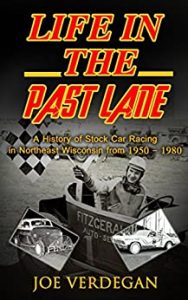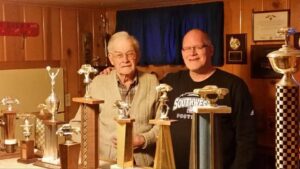The Vault
EARL NESS – A GREEN BAY RACING LEGEND
Posted on: Thursday October 6, 2022

If you like the chapter you’re reading from this book it is available for purchase at this website. Simply click on the upper left “books” tab.
A chapter from the 2015 release “Life In The Past Lane”………Green Bay racing champion Earl Ness.
When it comes to the coupe era in Northeast Wisconsin there wasn’t a driver who had more success on the track than Earl Ness of Green Bay.
Ness, who was 94-years-old when this book went to print, won several track championships and an estimated 400 feature wins.
One of his first crowns was the Interstate driver championship in 1951, which was awarded to the top driver at three Upper Michigan tracks, including Norway and Escanaba ovals.
From there Ness continued his winning ways, winning crowns at tracks at Seymour, Shawano, Luxemburg and his hometown at De Pere at the Brown County Fairgrounds. Ness’ last crown came winning the old Wolf River Racing Association (W.R.R.A.) in 1969. He also won the Seymour title that year. The W.R.R.A. sanctioned events at the half-mile ovals at both Shawano and Seymour.
Ness’ 1st race was at De Pere in 1950. “We had the third-mile paved track inside of the ½ mile horse track which was dirt,” said Ness.
Unlike modern times where pretty much every part of the race car is purchased from a high-priced manufacturer, Everything in the coupe era was built. The cars were often death traps, crudely built with blood, sweat and tears and pair of thick, meaty hands. Most everyone knew how to use a welder back then. We built pretty much everything from the scrapyard. Earl’s cousin Gayle Ness owned the car during the coupe days. “We’d have maybe $200 invested in the car total back then – it was pretty affordable.”
With gas priced at the pumps roughly at .25 cents a gallon, it made racing and traveling to race real easy on the pocketbook. “Gas wasn’t even a factor we considered back then really,” said Ness. “We’d think nothing of driving several states across the country to go race.”
Quite the contrast to the near $8.00 per gallon racing fuel teams must fork over to put a car on the track each night. The race cars themselves used regular pump gas. Unless the clever drivers added a few “additives” which weren’t necessarily “legal” per se. Pit passes were typically $10.00 while an adult ticket at most area tracks during the coupe era were $1.25.
“I recall John (Marquis) called a promoter from a race track down in Missouri on my behalf one time,” recalled Ness. “We drove all the way down there and raced. John would do things like that for us. He was a real good race promoter, and he treated the drivers well.”
Back in the day drivers raced for a percentage of the front gate receipts. In layman’s terms, the bigger the crowd on any given race day the bigger payout for the drivers. “It would be around $110 to $135 to win a feature on average,” recalled Ness. “I remember my biggest payout was a race I won out of town in Dubuque, Iowa. I think it was IMCA sanctioned and I remember taking home $1100 or $1200 which was a big deal at the time.”
Like most race teams in the coupe days Ness kept his race car at the family service station on West Mason Street on Green Bay’s west side.
With tracks in De Pere, Seymour, Shawano, Luxemburg and others at Shiocton, Brussels and several within an hour and a half of Green Bay drivers could easily race several nights a week. “I remember one time there were some specials strung together and we raced seven nights straight one time,” explained Ness. “I remember driving back all night from a track up north and rolling into my driveway at 5 a.m. I took a shower and went to work.” Ness worked for the City of Green Bay in their Forestry Department.
Around the turn of the decade in 1969 and 1970 Ness dabbled into the full sized race cars. It was part of a major transition in local racing history. “Those bigger sized cars were a lot more work and a lot more money,” said Ness. “Mainly because you could run so many different gear ratios for the different tracks.” Ness would travel to Iowa frequently and compete in IMCA sanctioned races, with a few USAC specials thrown into the mix from time-to-time.
Today’s high-tech savvy racing includes social media where drivers of certain brands of chassis frequently trade information and other speed secrets. “Back then, especially with the coupes, if you found something that made you fast you kept it a secret,” said Ness. “We didn’t share information with one another.”
The last year Ness wheeled a car full time was 1969. He raced a handful of times in 1970. The following year Ness traded in his helmet for a set of flags. He became the flagman or the “starter” for the Sunday races at De Pere.
According to a Green Bay Press Gazette article written by Jim Zima in May 1971 Ness said “I always did thing a flag man should be a past driver. I think you command a little more respect and maybe I’ll have fewer arguments because the drivers figure when I make a decision I know what I am doing.”
Over the years Ness earned a reputation for being a clean driver, in an era where the “bump-and-run” style was more the norm. He’d rather driver around an opponent than through them. Ness won the W.R.R.A. Sportsman award in 1968. “I really did become friends with all of those guys eventually,” said Ness. “I really liked racing against Bobby Marquis.”
What accomplishment is Ness most proud of? “We went to race at the Milwaukee Mile towards the end of my career. It was a USAC race so we had to buy a membership to join their club,” said Ness. “I was always the top guy around here but I had a pretty good run when I went down there. Those guys had much bigger motors and stuff. We couldn’t really hang with them but it was neat to run on that big track down there.”
Ness hasn’t attended races regular for many years. His last official win came in a Legends race at Wisconsin International Raceway in an exhibition event during the Dixieland 250 on the quarter mile in 1991. Out of the two dozen trophies remaining from his racing days, that trophy is the biggest. “I used to have more than 100 over the years but you end up giving ‘em away – I think the grandkids got a lot of ‘em,” said Ness.

Author Joe Verdegan poses next to 94-year-old racing legend Earl Ness. Ness was the first interview Verdegan conducted for the 2015 release of “Life In The Past Lane.”
The Ness name in racing has continued locally. Greg Ness (Earl’s second cousin) raced hobby stocks and modifieds in the 1990’s and into the 2000’s. Greg’s daughter Jessi Ness competes in IMCA northern sportmod. Ness was inducted into the Luxemburg Speedway Hall of Fame in 2010. Ness remains retired and lives with his wife on Green Bay’s west side.


